- Home
- Learn Linux
- Learn Electronics
- Raspberry Pi
- Programming
- Projects
- LPI certification
- News & Reviews


This is a project that I undertook during June 1996 as my final year electronics project. The entire circuit was built using individual components including logic gate ICs and and keyboard decoder IC. Since them electronics has moved on and if this was created today most of the functionality would instead be implemented using a microprocessor / micrcontroller such as the Arduino prototyping board. This is however an example of how circuits can be designed using logic components.
This includes a full write-up of the decision process and the calculations used in identifying the appropriate components for the circuit.
June 1996
The crime rate in the UK is high and thefts pedal bicycles is on the increase. The reason for this increase is due to the increase in the cost of the bikes (many bikes now cost around £300), and due to the lack of security devices for bikes. The conventional bicycle lock is prone to thiefs who can break the chain links with a pair of bolt croppers. The bike locks also suffers in that it cannot protect against the theft of the bicycle lights or other attachments. The solution to this is an intelligent burglar alarm that can detect both the movement of the bike or the removal of accessories.
The need for an alarm is evident and so a list of specifications has been drawn up indicating what the circuit has to meet up to. Although there are no commercial bike alarms to compare this system with there have been a couple published in magazines for hobby electronic enthusiasts, these turned out to be very simple devices that were often activated while trying to turn the device off. The local police force were contacted for any advice and the following list of specifications has been drawn up.
1. To set the alarm off when the bike is stolen I have decided to use a vibration sensor. This is triggered by movement in any direction from any other position. Unlike a mercury tilt switch the vibration switch can be left in any position.
2. The theft of the accessories could be done in many ways. The method I intend to use is aluminium foil on the lamps connected to the alarm by a contactor. The alarm will therefore be triggered by either the removal of the lamps or if the wire is cut. I am also incorporating a "part set" state for when the lights are left at home and to prevent the alarm sounding in this case.
3. The anti-tamper is to be achieved by a micro-switch inside the box that is switched by the removal of the case lid and a foil wire around the alarm and bicycle frame to prevent the alarm being removed.
4. An auto-reset could be achieved in many different ways and is explained in the circuit description.
5. This is to be entered on a membrane numerical keypad and is described under the circuit description.
6. This is in the form of a tri-colour LED that is lit by pressing a key on the numerical keypad. This prevents unauthorised persons using it as pressing the wrong number will activate the alarm. The correct number can be set by the operator.
There are 2 main types of keypad output that can be used. One is the telephone type where all the switches are connected to a common rail and the matrix output keypad which gives an output similar to a computer memory by having addresses relating to each switch. The type of keypad to be used is dependant upon the PIN (Personal Identification Number) decoder. Both types of keypad are shown below.
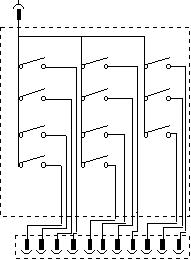
The above is a diagram of a telephone type numerical keypad. The keypad has a common rail which all the switches are connected to.

Above is a diagram of the layout of a typical matrix output keypad. The address matrix can be clearly seen. ( for example if the top left hand switch was closed then the switch B1, A1 would be closed).
As can be seen the telephone type keypad gives out a logic level output (TTL & CMOS will need a resistor for the common rail and from the output to the zero volts rail to prevent false signals caused by floating inputs). The matrix output keypad would require a complex decoding circuit if it was to work with standard logic ICs.
In most cases it is often cheaper and simpler to use a standard IC and adapt it for a particular function than to use logic gates to create your own circuit. This case is no exception. For the decoding of the PIN from a keypad there are two ICs that are readily available. These two are outlined below.

The IC is in a standard 14 pin DIL package.
Other features - include:
The above table shows the electrical characteristics for the IC.
Below is a circuit diagram using a lock and unlock relay for the opening and closing of a door.

This IC does not have a key-in echo circuit, but if one was required a multi input OR gate could be used.
To set the alarm the supply must be disconnected. To achieve this a transistor switch is used to disconnect the supply when the full or part set switch is pressed. This is achieved using a NOR gate (IC2D).
This is a 18 pin IC which uses a matrix output type keypad. The PIN number can be separately programmed directly from the keypad. This makes programming much easier. The pin layout is shown below.

The table below describes the use of each of the pins.
Below is a table for the ICs electrical characteristics.
The IC is CMOS compatible and has a key-in echo, which bleeps every time a key is pressed. The following circuit would have to be fairly complex to use this IC. Below is the circuit diagram if the IC was for use as a door opener.

The choice of the decoder was based on two main factors. The first was the required complexity of the following circuit. As the RS7225 gave fixed output levels the IC could drive combination logic directly whereas the UA3730 would require special sequential logic to decode the outputs.
The second factor was cost. The cost of the two ICs is very much the same but the cost of the required keypad was much cheaper for the telephone type keypad. Also a membrane keypad was available for the telephone type which gave a level of waterproofing.
The RS7225 was therefore used.
As the RS7225 required the disconnection of the supply to reset the outputs a transistor switch has been used to disconnect the supply and reset the alarm. This is triggered by IC2D which is connected to the part set and the full set selections which switches TR1.
The alarm set indicator is taken from pin 8 on IC1. As a warning to potential thiefs the LED was to flash on and off at a constant speed. This alerts the thief better than a constant light as a flashing light is much more obvious and more noticeable. This could be achieved by using 2 methods, a 555 counter or a different astable firing a transistor hence switching the LED on and off.
The 555 astable is shown below.

The 555 requires an IC, 3 resistors and 2 capacitors. This method is expensive and bulky and the 555 is not very economical on the battery's charge.
The frequency of flashes can be calculated using the following equations.
f = 1.44 .
C (RA + 2 RB)
By using NOR gates with buffered outputs and a RC network a square wave oscillator can be set up. This is shown in the drawing below.

The enable input would come from pin 8 on IC1 which would switch the astable on and off. When in the off state then the current consumed would be very low. When in the flashing state the current consumption would still be lower than the 555s. The frequency is equal to the multiple of the capacitance and the resistance.
This circuit only requires ½ a (Quad 2 input) NOR IC, 1 resistor, 1 capacitor, and 1 transistor (the other resistor is for current limiting the LED and would be required anyway. It is very important that the NOR gates have buffered outputs, but most CMOS ICs are buffered anyway and so this is not a deciding factor.
The NOR solution is the simplest and cheapest. It also has a lower current consumption and so is used. This forms IC5B and IC5A and drives LED1.
The time constant used is a 0.3 seconds giving a frequency of about 3 Hz. This is slow enough to be seen but fast enough so as it can be seen within a short time period.
This time constant was given by using a 100nF capacitor and a 3.3MΩ resistor. These were the nearest standard values. This gave a reasonable flashing rate when tested on breadboard.
This is the method in which part or full set mode is selected. As mentioned earlier this is to allow protection of the night lights when they are fitted and to prevent incorrect triggering if they are not fitted.
To set the alarm (regardless of part or full) IC2D was used to trigger TR1 and disconnect power from the IC. This is mentioned earlier under the PIN decoder section.
The decision for set or part set is selected by means of an RS flip-flop. The flip-flop could have been obtained by two methods. One method is to use a RS flip-flop IC this method is expensive and bulky as the IC packages contain 4 flip-flops.
The other alternatives is to create the flip-flop using NAND or NOR gates. The method that has been used in this case is to use NOR gates. This is as NOR gates were been used for the rest of the alarm system (see the section on the alarm status decoding circuit page 13).
A simple flip-flop has been used as only the Q output is required and the disallowed state will not effect the operation of the circuit. The flip-flop circuit can be seen below.

The R is the set input and the S the reset output. The Q is the output. The truth table for this flip-flop is shown below.

As can be seen from the truth table S and R both high is the state for which is not normally allowed. This is not important in my case as  is not used and as Q indicates full set the alarm would be full set anyway.
is not used and as Q indicates full set the alarm would be full set anyway.
The alarm status decoding circuit is the circuit which monitors the logic inputs and gives an output as to whether the alarm is to sound. This is a complex circuit and a truth table and Karnaugh map have been made up to simplify the circuit as much as possible. These are shown below.
To simplify truth table and Karnaugh map D and E are ORed together and is therefore referred to only as D in the karnaugh map.
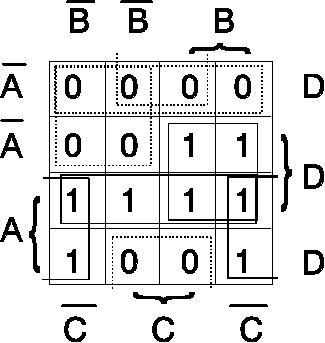
The "0"s have been circled with dotted lines and the "1"s with solid lines. This gives the Boolean expression below.
| Linking the "0"s | Linking the "1"s |
|---|---|
| f = 1 = A.D + A.C + D.B | f = 0 = A.B + A.D + C.D |
| In NAND only | In NOR only |
| f = 0 = (A.D) . (A.C) . (D.B) | f = 0 = A+D + A+B + C+D |
| f = 1 = A.D . A.C . D.B | f = 1 =A+D + A+B + C+D |
The above NOR only and NAND only circuits have been drawn in circuit diagram form on the following page.

The above circuit uses 4 two input NAND gates and 1 three input NAND gate. Two ICs would therefore be required for this circuit.
For the addition of the D and E the below addition would be required to replace the "D" input.

By the addition of the above circuit this would add a further 3 two input NAND gates and the circuit would then require a total of 7 two input NAND gates and 1 three input NAND gate requiring 3 ICs.

The above circuit uses 4 two input NOR gates and 1 three input NOR gate. Two ICs would therefore be required for this circuit.
For the addition of the D and E the below addition would be required to replace the "D" input.

By the addition of the above circuit this would add a further 2 two input NOR gates and the circuit would require a total of 6 two input OR gates and 1 three input OR gate which could be contained in 2 ICs.
The NOR only solution is therefore the simplest at this stage.
Some kind of latch was required for the full/part set selection. The simplest way of achieving this is to use a SR flip-flop. In a IC there is normally 4 flip-flops and to use this for only one would be a waste of PCB space as well as expensive. It was therefore required to make one using logic gates. As the S and R inputs will not be selected together (this would give both Q and Q high on a simple flip-flop which is an invalid state) a simple SR flip-flop can be used. The NAND only and NOR only flip-flops are shown below.
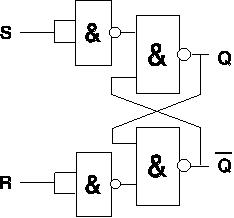
The above flip-flop requires an additional 4 two input NAND gates and would therefore use another IC.

This solution only requires 2 two input NOR gates which is ½ a 4 gate IC.
NOR only logic is used as the number of gates used is much less and less ICs are used.
To give a automatic reset in the event of false triggering a circuit is to be incorporated. There are several ways in which this could be achieved but the easiest is by the use of a monostable. The monostable would be triggered by the decoding circuit and the monostable would trigger the alarm for a set length of time. This would act like a latch but would reset itself after the set length of time has passed.
One method in which a monostable can be made is by the use of a 555 timer IC. This IC allows the time to be varied easily (by changing a resistor or capacitor) and consumes very little current in the standby mode.
The circuit diagram is shown below.
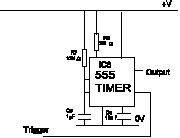
For the monostable to work the resistors and capacitors have to be calculated. This is achieved by using the equations from the data sheets. The time constant to be used is 10 seconds this allows a quick reset in the event of false triggering but prevents the alarm being reset in the event of a theft.
T = 1.1 RA . C
Using a 1µF capacitor
RA = 10s
1.1 x 1µF
RA = 9090909Ω
RA = 10MΩ
The 555 gave an on time of approximately 10 seconds. A 10nF capacitor is used on the control pin to the zero volts rail and the reset is held high via a 330Ω resistor.
The sounder could have been made in two ways. The first is to use an astable multivibrator to drive a transistor and a loudspeaker. The problem with this is that to produce a loud enough noise a very large, heavy loudspeaker is required. This also has a very high current consumption.
Instead a piezo siren was used. These have the advantage of being loud, whilst also being small and not drawing excessive currents. The one used is a miniature siren from Maplin and proved to be effectively loud.
Below is a table of the sirens current consumption at different voltages.
The siren doesn't require complex circuitry to drive it (eg an astable multivibrator) although the 555 is not capable of driving it correctly therefore a transistor switch is used. This configuration is shown below.

The BC108 was used as it is capable of driving the siren (allowing for a safety factor of 1.5) and is readily available. It has also been used previously in the circuit and so it was ordered together.
As the alarm is to be battery operated some form of indicator must be used to allow the operator to check that the batteries are not flat. The indicator should be selectable so as not to inform any potential thiefs when the battery is flattening. This is achieved by integrating the switch on the keypad. This is achieved using a transistor switch being fired by an astable multivibrator (so as to reduce current consumption by approximately half). The multivibrator uses NOR gates as the one on page 10. This transistor then switches the supply to the voltage level indicator.
There a several indicators that can be used including bargraph displays and single LED indicators that show a flat battery. To be easy to see and to make the indicator as easy to read as possible I have decided to use a tri-colour LED which can have all number of colours from green for a good battery, yellow for a suspect battery and red for a flat battery that needs replacing.
The circuit works by having zener diodes biasing transistors to come on changing the strength of the red and green elements within the LED. The circuit can be seen below.

The two zener diodes are used to set the voltage at which the battery is treated as flat. The zener diode on the left should be around 9V where as the one on the right should be around 7.5V for use on a 9V battery.
A printed circuit board was made for the circuit. The original intention was to make a single sided PCB but later on this proved to be impossible so a double sided PCB was made. The templates were drawn on the computer and a laser print out made. the print out was photocopied onto acetate to make a mask for photoetching the PCB. The templates used are shown below (50% actual size).


The pictures of bicycles line up on the component and track side and was used to ensure that the two sides line up.
As a later thought I felt it necessary to add a further circuit to prevent the alarm from being accidently triggered when the alarm is being set or if another bike is lent against it. The circuit diagram is shown below.
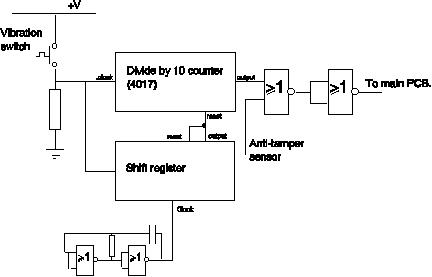
The circuit will only trigger the alarm if 10 pulses pass through in the time taken for the shift register to count through which is determined by the resistor and capacitor and the astable circuit.
The circuit was built on stripboard but due to lack of time a PCB was not made.
The price list is shown below:
A few problems were encountered during the construction of the circuit. These are listed below:
1. Problems lining up the track and component side of the PCB. This was solved at the second attempt by Sellotaping the PCB to the acetate sheets.
2. A few of the tracks on the acetate were very thin or had holes in. To overcome this the PCB had to be touched up with etch resist pen prior to etching the PCB.
3. A connection was missing on the PCB. As there was not enough time to build the PCB again a wire link had to be connected on the underside.
4. Two inputs to the SR flip-flop had not been tied to ground using a resistor. As there wasn't enough time to make another PCB these have been soldered onto the back of the PCB.
5. The connectors used to change the PIN are very difficult to use and change. The connecters were chosen as they were cheap and readily available. A better connecter should have been used.


Tooley . M, Everyday Electronics, (periodical) London. 1989-1992
Maplin, Electronics, (periodical) London. 1991-1992
Elector Electronics, (periodical) London. 1990-1992
Practical Electronics, (periodical) London. 1991-1992
Freeman . P, Electronics Today International, (periodical) Hempstead. 1992
Maplin, Maplin sales catalogue and Data Sheets, London. 1992
Farnell, Farnell sales catalogue and Data Service, Leeds. 1992
RS, Sales catalogue and Data Library, London. 1992
Green D. C., Electronics Level II, London.
Green D. C., Electronics Level III, London.
Please view the copyright information regarding use of the circuits.